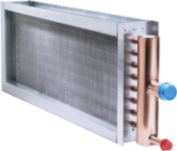Different Types of Steam Coils
by Dan Jacobs, October 10, 2023
There are two types of steam coils: standard steam coils, which are used in most reheat applications, and steam distributing coils, which are used in applications where the entering air temperature is below 40 F degrees. Many times, this type of coil is also known as a “non-freeze” coil, but that name is misleading because in reality, there is no such thing as “non-freeze”.
Standard Steam
Standard steam coils operate a lot like hot water coils, but the construction is very different even if the coils appear to be constructed the same. The supply and return connections are often on the same end like a hot water coil. But, steam is very different than hot water, and the coil must be built for and circuited for steam. Keep in mind that steam is always more erosive than hot water. The brazing and tube wall thickness must account for steam. ALWAYS remember that even low pressure steam is more erosive than hot water, and a steam coil needs to be built accordingly.
Steam Distributing (Non-Freeze)
Steam distributing coils are a completely different type of coil because they are constructed as a tube within a tube. Every place that you see an outside tube or header, there is an inside tube and header that you can’t see. The steam on the inner tube keeps the condensate in the outer tube from freezing. The purpose of the  original coil design was to distribute the steam evenly along the length of the coil and to eliminate any dead spots on the coil. A byproduct of this coil was also found. The coils didn’t freeze nearly as easily as the standard steam coil, so the coils became known as “non-freeze”, which as mentioned, is not completely accurate. Any coil can freeze under the right conditions, but, this design is what needs to be used when the entering air is under 40F degrees!!!
original coil design was to distribute the steam evenly along the length of the coil and to eliminate any dead spots on the coil. A byproduct of this coil was also found. The coils didn’t freeze nearly as easily as the standard steam coil, so the coils became known as “non-freeze”, which as mentioned, is not completely accurate. Any coil can freeze under the right conditions, but, this design is what needs to be used when the entering air is under 40F degrees!!!
Steam Coil Design
Steam coil designs can be very tricky. Steam coils are totally a function of the system and installation, while other coils operate more independently of the system. There needs to be correctly designed traps, and they need to be installed in the correct place and depth in the system. Often, vacuum breakers are also needed in the system. The piping must also be installed correctly to make sure the steam is entering the coil and not the condensate. Even with all of those factors, you’ll need a correctly designed steam coil that matches the steam pressure, length of the coil, and the entering air temperature. Coils can freeze easily. Coils can be too long in length and the steam cannot travel the length of the coil and distribute evenly. Condensate can easily be trapped somewhere in the coil, and the result is water hammer.
Capital Coil & Air has years of experience designing steam coils, and is here to answer any questions and help to design the right coil for your project!
Related Topics
Frozen Steam Coils: How to Prevent it!
Commercial Steam Coils; Lengths & Controls
HEATING SEASON WILL SOON BE UPON US
Tags: "Non-Freeze Coils", After-market, Capital Coil & Air, Chilled Water Coils, Facility Managers, Heating Coils, HVAC Coils, Quick-ships, replacement coils, Service Managers, Standard Steam Coils, Steam Coils, Steam Distributing Coils
